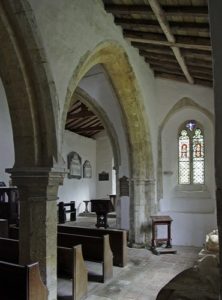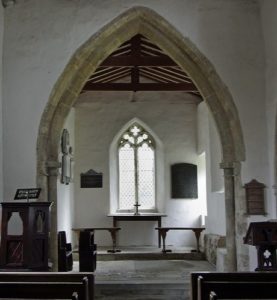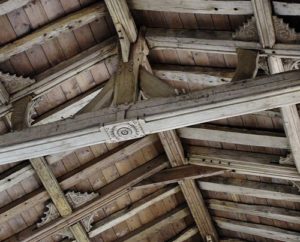This had been an important ecclesiastical site between the Wolds and the River Ancholme. and in medieval times there had been a castle, tithe barn, vicarage and planned village. In the 13thC the castle had been replaced by a manor house which belonged to the Disney Family in the 14th& 15thC (ancestors of Walt Disney) and their monuments are in the church.
By the 19thC the Vicarage and manor house had been rebuilt. The tithe barn pulled down and the village gone. All that is left are a few bumps in the ground.
The church is surrounded by old hay meadows which are now a National Site of Scientific Interest and the remains of ridge and furrow can also be seen.
The are has been settled for over 2500 years and it has been suggested that the church was built over a scared spring. The west wall is the oldest part of the church and is a thousand years old.
It is in a lovely setting in the depths of rural Lincolnshire and feels very much as if time has ignored it. It survived the Reformation and the Civil War and Oliver Cromwell unscathed. Now it is no longer in use and cared for by the Churches Conservation Trust along with a local trust. It is always open.
It is surrounded by a church yard with old gravestones and trees. The lead roof was stolen and replaced by red pantiles. The squat tower is 12thC and is unusual as it leans against the older west wall and is not attached to it. It has narrow double windows. There is a nave, south aisle with porch later porch and chancel. The north aisle has gone. At the west end of the south aisle is a later double stained glass window with a trefoil at the top. and two caved heads. One has a crown and the other is a lady.
Inside it is a simple but attractive building. At the top of the west wall is a small round window, a feature sometimes found on Saxon churches, which would have admitted the light of the setting sun.
One octagonal pillar supports pointed arches which separate the nave and south aisle. The walls are whitewashed which is a 20thC choice. Originally they would have been ocher. The wood roof is 17thC and has carved bosses and triangular carvings at some intersections. Furniture is 19thC. The Bible is a family Bible dates 1819 and left to the church.
At the back an ogee stone arch and wooden door lead into the tower which has a ladder to access the bell chamber. There is a simple hexagonal 13thC font and a poor box carved from a single piece of wood on a stand inscribed with "This is God's treasury. Cast on mite into it. 1639."
The 19thC stained glass window at the west end depicts St Paul and John the Baptist and is in memory of Rev James Walter who was vicar of Market Rasen for 53 years and his wife Francis. At the end of the south aisle is one of the treasures of the church as it is 14thC stained glass and has a small image of St catherine with a small wheel beside her and St Cecilia playing a hand held organ. Above on is a small window with Christ on the cross on a blue background.
The other highlights of the church are the Disney memorials. In the south aisle are two stone tombs thought to have been moved here from the north aisle.
Nearest the door is William Disney (d. 1316) in chain mail surcoat with a large shield and puppies by his pillow. His legs are crossed and rest on an unidentified animal. Next to him is his son, another William (d. 1349). He fought alongside the Black Prince. Again he is wearing chain mail with a metal helmet He is praying and has leopards on his surcoat and an impressive belt holding a sword. He has lost his legs but his feet in armour are resting on what could be a lion. Round the base of both tombs are coats of arms.
There is a pointed chancel arch and steps lead into the chancel and to the altar. There is a simple wood altar rail and a simple wooden table altar. There are old grave slabs on the chancel floor. On the south wall is a stone slab with the figure of a knight. This represents Henry Disney, who was a cleric before returning to farm his father’s land in 1344. His body is covered with an elaborate cross with small heraldic shields on either side. His head with long flowing hair and praying hands are at one end and his feet at the bottom.
On the east wall is a wooden board with the creed, On the chancel walls are Victorian marble memorials to the Young family who owned the manor in the 19thC.
This is a lovely church in a very unquiet and unspoilt part of the county.










